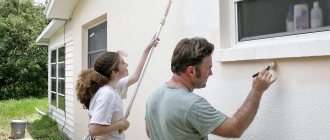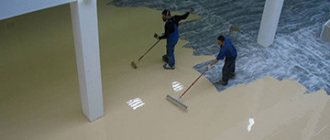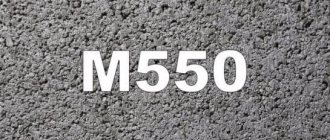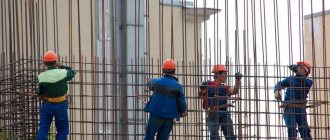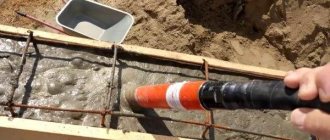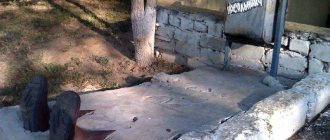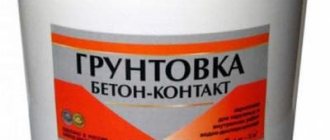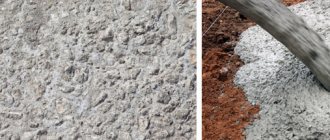SHARE ON SOCIAL NETWORKS
FacebookTwitterOkGoogle+PinterestVk
Concrete floor paint helps protect the surface from wear and damage that may occur during operation. Even taking into account the narrow purpose, the range of compositions on the market can confuse the buyer. This article will help you understand the features of protective coatings for concrete surfaces, as well as choose the best paint option for interior and exterior work.
Painting a concrete floor will protect it from damage and rapid wear.
Painting concrete surfaces - what are the features?
Untreated concrete base is hardened cement, porous and coarse-grained. This texture quickly begins to crumble and become dusty even with minimal impact; when moisture gets in, the concrete breaks down even faster. Water washes out some components of the composition, and at low temperatures freezes in the pores, reducing the strength of the material.
To eliminate these problems, strengthening substances are introduced into the cement mixture, and then additionally stabilized using painting, which eliminates dust, smoothes out roughness, fills the loose structure and protects from moisture, and forms a resistant film that prevents the material from crumbling.
Concrete walls, ceilings, floors, foundations and sidewalks can be painted.
Note! It’s good if the enamel has good hiding power and one layer is enough to completely change the original color of the concrete.
Advantages and features of concrete
The advantages of concrete are:
- the surface on which the concrete product is applied acquires increased strength;
- such material is able to cope with negative environmental phenomena (in the case of the exterior decoration of a building);
- laying concrete is simple and elementary;
- product strength at the highest level;
- the quality is high and the price is low.
In most cases, floors are made of concrete on streets and in industrial premises, basements or garages, and so on. This coating is in demand due to the fact that it can withstand high-level loads.
If we talk about the disadvantages of concrete coating, we can note the release of dust during its use. This problem can only be solved by applying an additional coating to the concrete surface. Most often it becomes laminate or linoleum. But experts say that the most suitable solution in this case may be decorative painting of the surface. This method is affordable and fast. And such application to concrete will provide additional resistance to wear of the material. In addition, painting concrete will give it aesthetics and attractiveness.
Types of concrete paints that are suitable for interior and exterior work
Concrete paint is selected based on several criteria. The most important is where the work is carried out - outside or inside the premises. For outdoor work, it is important that the material is resistant to low temperatures and UV rays, moisture resistant, dries quickly and looks aesthetically pleasing.
Indoor paint must be safe for health and not contain highly toxic components. For both indoor and outdoor work, the paint should protect the concrete from moisture.
Basic requirements for paint, regardless of where it is used:
- good adhesion,
- vapor permeability,
- abrasion resistance,
- economical consumption.
Classification by composition and type of surface to be painted
To get the desired result, experts recommend paying great attention to choosing the right paint for concrete. There is a lot of different information on the Internet, but there is a standard gradation of materials according to composition and type of surface to be painted.
You can list the main materials by composition:
- Acrylic. These paints are popular not only for concrete surfaces. They contain special polymers and their derivatives, under the influence of which a dense, elastic, breathable film is obtained. Among the advantages of acrylic paints, it is worth noting wear resistance, economical consumption, low price, good hiding power, ease of application, durability of the coating, high drying speed and the ability to use in moderately damp rooms.
- Among the disadvantages, they note the need for careful preparation of the surface for painting, including preliminary priming.
- It is important not to confuse acrylic and alkyd enamels. Alkyd paints are oil paints. They form a hard film on the surface, whose performance properties are worse than those of acrylic compounds.
- Epoxy. They contain epoxy resin and hardener, which must be mixed with a construction mixer to obtain finished enamel. The result is that a waterproof, durable film hardens on the concrete base, which is resistant to any type of impact and retains its appearance for a long time. Therefore, it is often purchased for painting concrete floors. Depending on additional components, the film can be flexible or rigid.
- Among the disadvantages is the possibility of an error in proportions during preparation of the composition.
- Vinyl. These paints create a beautiful matte surface, dry quickly, cover well in one coat, are odorless, environmentally friendly and hypoallergenic. However, now they have almost been replaced by acrylic analogues, since the service life of vinyl coating is no more than 7 years, it is not moisture resistant enough and almost does not “breathe”, which means that concrete deteriorates faster.
- Polyurethane. This is an ideal paint for concrete floors. Particularly resistant to abrasion and mechanical stress. The only negative is the long drying time; complete drying takes up to two weeks.
- Rubber. The consistency is similar to mastic, which after drying resembles rubber. The coating is very durable, but at the same time elastic due to the acrylate latex in the composition. One of the advantages is frost resistance: you can work with paint outside even at -50 degrees. Latex paints are often used on playgrounds and sports fields.
- Water-based. The main component of paint is water, so such materials are non-toxic, easy to wash off, do not smell and are available in a wide palette of shades.
- Silicone emulsion. One of the best offers in terms of its characteristics on the market. It can be used within two days after the concrete has hardened. The enamel forms a completely waterproof, but at the same time “breathable” coating, has high adhesion, is elastic, and wear-resistant. The only drawback is the very high price.
Depending on the surface that is supposed to be painted, there are:
- Concrete enamel for facade. Concrete walls of buildings must be protected from aggressive environmental influences. What is important here is the high penetrating ability of the composition and economical consumption, as well as service life, since repainting building facades is not a very fast and labor-intensive process.
- Foundation paints. Acrylic, polyurethane, epoxy, and silicone compounds are suitable here. When choosing, you need to be guided by the characteristics of concrete and environmental factors. For example, for cold regions, paints based on epoxy resins are used.
- Floor paints. Paints for concrete floors must meet several criteria - resistance to abrasion and mechanical damage, as well as moisture resistance. Polyurethane, acrylic, rubber, epoxy enamels have these properties.
- Materials for painting paving slabs, concrete garden paths and blind areas. The same requirements apply to these paints as to floor paints. But additional attention is paid to protection from precipitation, so acrylic compounds are not suitable here.
The best paints for wood floors
This segment contains products whose qualities will appear the moment they are applied to wood and fiberboard coatings. Unlike clear varnish, the dye completely changes the look of the wood, adding some shade to it
Therefore, before buying a product, it is important to find out about the color palette. During the selection, emphasis was placed on the absence of strong odors, resistance to wear, and ease of application.
When comparing 7 colors, only 3 were selected.
Domalux Alkosol
Domalux Alkosol is a wear-resistant floor paint from a manufacturer in Poland, resistant to abrasion, mechanical damage, and scratches. Used for painting wood and derivative materials indoors (wood floors, parquet floors, furniture and interior elements). Recommended for painting surfaces in apartments, offices, hospitals, schools, and other facilities. The painted coating will acquire wear-resistant properties after 3 days. The developer “Domalux” has a small palette of 6 shades, which is typical for alkyd dyes. However, the colors are bright and relevant for the garden.
The dye is suitable for painting wooden floors, doors, frames. Applies evenly to uneven surfaces, covering all surface defects. The product has a pleasant smell, the sweet aroma will disappear after 2 hours.
Advantages
- Dries quickly;
- Nice smell;
- Uniform application;
- 1 layer is enough;
- Bright shine, rich shade;
- Resistance to moisture;
- Suitable for indoor and outdoor use.
Flaws
- Gets thick quickly;
- The coating will be very slippery.
Based on reviews, you need to work with this product extremely quickly, as after 2 hours it will begin to thicken. Without odors typical of most analogues.
Tikkurila Pika-Teho
Matte, wear-resistant acrylic floor paint that contains oil. It is used for painting external wood coverings: walls, cladding boards, fences. The composition of natural oil protects the facade of the building from rain, snow, and ultraviolet rays for a long time. Due to such strength and elasticity, the dye adheres well to wood and eliminates the hassle of painting for at least 20 years. The product is produced in Finland and is in great demand due to its high quality and economical use.
It fits well, there are no smudges left, and there is virtually no pungent odor. If the required working conditions are observed, the next layer can be laid after 3 hours. This product is tinted in 120 shades from the manufacturer’s catalog, which are resistant to fading. The user can dye with the main composition when it is necessary to obtain a white tint.
Advantages
- Natural ingredients;
- Protection from moisture, ultraviolet rays;
- Durability;
- Economical use;
- Strength, elasticity.
Flaws
There will be a slight smell left.
Users note the economical consumption of dye and immunity to sunlight. Each component of the product has a natural base.
PF-266 Lakra
The choice of colors is small, limited to 3 shades: brown-yellow, brown-red and golden. The listed colors are versatile and meet the wishes of many customers. The final drying period will be one day per layer, while furniture placement is permissible no earlier than 6 days. When the user has time, is not in a hurry and is willing to tolerate the presence of unpleasant odors for 5 days in exchange for the quality and durability of the coating, it is recommended to buy such a dye.
Advantages
- Not afraid of moisture, temperature changes, ultraviolet rays;
- Quality of the painted surface;
- Durability;
- High resistance to mechanical damage.
Flaws
- Poor choice of shades;
- A pungent odor accumulates inside the room.
How to choose the right paint
To choose a good paint, it is recommended to pay attention to several points.
First you need to assess the intensity of use of the concrete base. For example, to paint walls you will need less wear-resistant enamel than to paint a concrete floor in a garage.
It is important where the painting will be done. For interior work, non-toxic, odorless enamel is required. For outdoor work, resistance to precipitation, UV rays and external damage is important.
Many manufacturers produce universal paints, and before choosing one, you need to carefully study the composition information on the label and recommendations for use.
There is a complete list of requirements for enamels for concrete, however, there is still not a single brand that could combine them all:
- waterproofing properties;
- resistance to low and high temperatures;
- fire resistance;
- health safety;
- neutral smell;
- resistance to physical and mechanical damage;
- ease of care.
The essence of painting the floor in the garage
At first glance, it seems that there is no particular need to paint a durable concrete garage floor, since it is initially made of a reliable material. However, if we turn to the physical and chemical properties of a poured concrete floor, then painting it becomes advisable for the following reasons:
- Concrete pavement has a porous, heterogeneous structure, as it is made from a number of components that differ in their characteristics. After the screed has matured, microscopic pores and cracks form in its structure, which provoke surface erosion of the hardened concrete and the formation of dust.
- The surface layers of the screed on a garage floor are subject to quite strong influences (for example, impact and abrasion loads), which can lead to erosive destruction in the absence of the necessary protection.
- Unpainted concrete during friction of any intensity is always covered with fine cement dust, which is almost impossible to get rid of, so a person working in the room will constantly inhale it. This process will negatively affect the lungs and respiratory system as a whole.
A well-chosen paint, combined with the correct application technology, will help paint a garage screed and give it a number of positive qualities:
- the wear resistance period will increase;
- service life is increased due to reduced erosive effects;
- no accumulated dust on the surface;
- increasing resistance to aggressive chemical compounds;
- moisture will not penetrate into the pores of the concrete, which will give the coating moisture-resistant qualities;
- the aesthetics of the appearance of the room increases, which allows increasing the productivity of the person working in the room and the quality of the results obtained;
- Quick and easy cleaning of garage flooring.
Before painting Before painting
Before painting
After coloring
Which wear-resistant material should I use for a concrete floor to avoid dust?
When deciding what to paint a concrete floor with, craftsmen recommend paying attention to deep penetration paints. The porous structure of concrete is very fragile and when the partitions between the pores break, the surface begins to gather dust. To avoid this, you need to fill the empty pores with paint, which will give strength to the material and increase its wear resistance.
There are two methods of painting concrete - deep and surface.
With deep coloring, the enamel penetrates deep into the porous structure of concrete, giving it a lasting color and improving the strength and durability of the material. This technology is quite expensive, so surface painting is often used.
Epoxy, polyurethane or rubber are commonly used as wear-resistant paints for concrete floors. Polyurethane can be painted in industrial premises due to its high resistance to mechanical damage.
Note! In order for the paint to adhere well, you must first prime the concrete screed. The use of deep penetration primer and paint will ensure optimal durability of the coating.
Dyeing technology
There are three ways to add color to concrete structures. The most durable option is pigmentation of the solution at the stage of its preparation. In this case, subsequent updating of the finish will not be required, since the appearance will remain unchanged under the influence of the sun or walking.
Solid coloring of concrete Source synrgi.dk
Another technology is called deep. Here, the components of the paints used enter into a chemical reaction with the substances contained in the concrete. The result is a single surface that is resistant to dirt, moisture and abrasives. The process is complex and expensive, but is justified by its durability.
The third option is the classic application of paint, which forms a protective film. Otherwise, the technology is called surface technology. The result is inferior in strength and service life to the other two, but costs less, the choice of materials is richer and implementation is simpler.
Preparing concrete walls for painting
The process of preparing concrete walls for painting consists of several stages.
- Surface cleaning, which may include: removal of old oil paint, removal of mold and dirt. If the concrete is fresh, cement laitance forms on its surface, which must be sanded after the material has dried.
- Removing dust from the surface (you can use a vacuum cleaner).
- If there are cracks and potholes, they are filled with plaster, putty or polyurethane foam.
- After the mixture has dried, the surface is sanded manually or with a special grinding machine and then primed.
Now you can proceed to painting, having previously carried out tinting. To do this, use a white base paint and add pigment.
How to paint concrete floors: preparation of the base and application technology
Using a two-component composition, you can paint old floors that have already been in use, as well as freshly poured screeds. Depending on the condition of the base, the preparation algorithm may be different.
If you plan to paint a freshly poured screed, you must wait five days for the concrete to gain strength. During this time, excess moisture will evaporate from the material, so it will be easier to process. Five days after pouring, the surface of the screed is ground using a tool called a “helicopter”. Sanding is necessary in order to get rid of the unstable top layer. It is a hardened cement “milk”. In addition, grinding removes minor surface defects and opens pores.
After this, all debris and dust are removed from the floor. To do this, you can use a construction vacuum cleaner. Since a freshly poured screed has an almost flat surface, there is no need to repair the base before painting.
Before painting, it is necessary to repair the floor, sealing all cracks and cracks.
If an old concrete floor is to be treated, you need to make sure that the surface humidity does not exceed 4%. Otherwise, the adhesive properties of the dye will deteriorate and after it dries, the coating will begin to peel off.
Algorithm for preparing an old floor for painting:
- Checking humidity using a special device.
- Removal of unstable areas, various defects and loose areas.
- Removing dirt (paint residues, oil stains, traces of bitumen).
- Preparation of cracks and crevices for sealing (the defect is worked out to a depth and width of 8-10 mm).
- Garbage collection.
- Surface primer.
- Seal cracks and crevices using repair compound or epoxy paint mixed with quartz sand.
Priming a concrete floor is an important step before painting the surface.
After repairing the surface, the patches must dry. They do not need to be additionally primed before painting.

